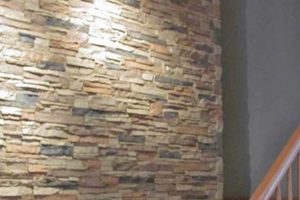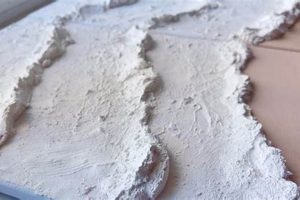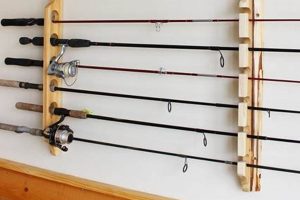The construction of a personal rock-climbing structure in a residential outdoor space enables individuals to engage in physical activity and skill development within a controlled environment. Such a structure typically involves bolting climbing holds onto a prepared surface, such as plywood attached to a sturdy frame, creating a simulated rock face. For example, a homeowner might build a climbing wall against the side of their garage, allowing for convenient and accessible exercise.
The primary benefit of establishing such a facility lies in its ability to provide accessible physical and mental training. It fosters strength, endurance, and problem-solving skills. Historically, climbing walls were largely confined to gyms and training facilities; however, recent trends have seen a significant increase in personal construction projects, driven by a desire for convenient fitness options and recreational pursuits.
Therefore, the following sections will address key considerations regarding the planning, design, construction, and safety aspects necessary to create a robust and functional outdoor climbing structure. This includes details on material selection, structural integrity, hold placement strategies, and essential safety measures.
DIY Outdoor Climbing Wall
The successful construction of an outdoor climbing structure requires careful planning and execution. Attention to detail and adherence to safety guidelines are paramount throughout the process.
Tip 1: Foundation Integrity: Prioritize a solid and level foundation. The structure’s longevity and safety depend on a stable base. Consider using concrete footings or a reinforced ground frame to ensure adequate support.
Tip 2: Structural Reinforcement: Employ robust framing techniques. Utilize pressure-treated lumber or steel for the main frame to withstand weather and climber weight. Cross-bracing and gusset plates are crucial for preventing racking and instability.
Tip 3: Panel Material Selection: Opt for exterior-grade plywood with appropriate thickness. Consider marine-grade plywood for enhanced weather resistance. Apply a sealant or paint specifically designed for outdoor use to protect against moisture and UV damage.
Tip 4: Hold Placement Strategy: Plan hold placement strategically. Vary hold types, sizes, and angles to create challenging and engaging routes. Ensure adequate spacing between holds to accommodate different skill levels and climbing styles.
Tip 5: Secure Hold Installation: Use appropriate hardware for attaching holds. T-nuts and bolts specifically designed for climbing holds are essential. Ensure that bolts are tightened securely but not over-tightened, which can damage the holds or panel.
Tip 6: Fall Zone Considerations: Establish a clear and safe fall zone. Use thick crash pads or a layer of soft material like wood chips or sand to cushion falls. Ensure the fall zone extends adequately beyond the base of the wall.
Tip 7: Weather Protection Measures: Implement weather protection strategies. Consider a roof or overhang to shield the climbing wall from rain and snow. Regular maintenance, including cleaning and re-sealing, will prolong the life of the structure.
Tip 8: Regular Inspections: Conduct routine inspections of the structure. Check for loose holds, damaged panels, and any signs of structural weakness. Address any issues promptly to maintain safety and prevent accidents.
These tips contribute to a safer and more enjoyable climbing experience, ensuring the structural integrity and longevity of the constructed climbing facility.
Following this guidance closely allows for the successful implementation of an outdoor climbing feature, transitioning now to concluding remarks about safety and responsible construction.
1. Structure Stability
The stability of a self-constructed outdoor climbing wall is paramount to its safe and functional operation. It acts as a foundational element, directly influencing the load-bearing capacity and overall integrity of the entire structure. The stability of the climbing wall mitigates the risk of collapse or deformation, safeguarding climbers from potential injury. A failure in structural integrity can lead to catastrophic consequences, highlighting the critical importance of meticulous construction and adherence to engineering principles. For example, an inadequately braced frame, subjected to the dynamic forces of climbing, can buckle, rendering the structure unusable and potentially hazardous.
Achieving the necessary structural stability necessitates a comprehensive understanding of material properties, load distribution, and construction techniques. Factors such as the choice of lumber or steel, the size and spacing of framing members, and the method of connecting these elements directly influence the wall’s ability to withstand the stresses imposed by climbers. Consider the scenario where insufficient foundation support leads to gradual settling; this can induce stress fractures in the frame and compromise the overall stability. Conversely, employing over-engineered solutions can lead to unnecessary costs and complexity, underscoring the need for a balanced and informed approach.
In conclusion, structural stability is not merely a desirable attribute but a fundamental requirement for any outdoor climbing wall. Its absence invalidates the entire project, rendering it unsafe and unusable. The challenges associated with ensuring stability lie in the need for precise calculations, careful material selection, and adherence to sound construction practices. By prioritizing and diligently addressing these challenges, the creation of a safe and enduring climbing structure becomes achievable.
2. Material Durability
Material durability is an indispensable element in the successful construction of a DIY outdoor climbing wall. The selection of robust, weather-resistant materials directly dictates the structure’s longevity and safety. Outdoor environments expose materials to fluctuating temperatures, moisture, ultraviolet radiation, and physical stresses, all of which contribute to degradation over time. The direct effect of compromised materials can be seen in warped plywood panels, corroded metal supports, or weakened climbing holds, creating hazards for users.
Consider, for example, the difference between using untreated lumber versus pressure-treated lumber for the frame. Untreated lumber is susceptible to rot and insect infestation, leading to structural failure within a few years. Pressure-treated lumber, conversely, undergoes a chemical process that significantly enhances its resistance to these factors, extending its lifespan and ensuring the wall’s stability. Similarly, exterior-grade plywood, designed with water-resistant adhesives, withstands moisture far better than interior-grade alternatives. Real-world applications clearly demonstrate the cost-effectiveness of investing in durable materials upfront, as it minimizes the need for frequent repairs and replacements. Practical understanding of these material properties is thus essential for efficient resource allocation.
In summary, material durability is not merely a desirable attribute but a critical requirement for any outdoor climbing wall project. Understanding the specific environmental challenges and selecting materials accordingly are crucial steps in ensuring the safety and longevity of the structure. By prioritizing durability, builders mitigate risks associated with material failure, reduce long-term maintenance costs, and create a reliable climbing surface for extended use. The correlation between material choice and the overall integrity of the climbing wall cannot be overstated.
3. Hold Security
Hold security represents a critical safety parameter in the design and construction of a do-it-yourself outdoor climbing wall. The integrity of the attachment between climbing holds and the wall substrate directly influences climber safety and the overall usability of the structure. Failure to adequately secure holds can lead to unexpected detachment, resulting in falls and potential injuries.
- Hardware Selection and Compatibility
The selection of appropriate hardware, specifically T-nuts and bolts, is paramount. T-nuts must be compatible with the thickness of the wall panel, ensuring sufficient thread engagement for the bolts. Bolts must be of appropriate length and diameter to securely clamp the hold to the wall without stripping the T-nut threads. For instance, using undersized bolts or T-nuts designed for thinner panels will compromise the holding strength, increasing the risk of hold rotation or detachment. Conversely, overtightening bolts can damage the hold or the T-nut, also weakening the connection.
- Proper Installation Techniques
Correct installation techniques are essential for maximizing hold security. This includes ensuring that T-nuts are fully seated and flush with the back of the wall panel before attaching holds. The use of a rubber mallet can aid in seating the T-nuts without damaging the surrounding wood. When tightening bolts, it is crucial to apply consistent torque using a torque wrench to avoid overtightening or undertightening. Furthermore, incorporating a locking mechanism, such as thread-locking compound, can prevent bolts from loosening over time due to vibration and repeated use.
- Regular Inspection and Maintenance
Periodic inspection of holds is a necessary aspect of maintaining hold security. This involves visually inspecting holds for cracks or damage and physically checking for any looseness. Loose holds should be immediately tightened or replaced, if necessary. Furthermore, the wall panel itself should be inspected for any signs of deterioration around the T-nut locations. Addressing these issues promptly prevents them from escalating into more serious problems that could compromise the entire structure.
- Hold Type and Placement Considerations
The type of climbing hold and its placement on the wall can influence its security. Larger, more aggressive holds exert greater leverage forces on the attachment points. Therefore, these holds should be positioned closer to framing members to distribute the load more effectively. Overhanging sections of the wall experience higher stress concentrations, requiring more frequent inspections and potentially the use of larger or more robust T-nuts and bolts. Strategically placing holds to minimize twisting or pulling forces can also contribute to long-term hold security.
Ultimately, hold security is an integrated element of a safe and functional climbing wall. The careful consideration of hardware selection, proper installation techniques, regular inspection, and hold placement directly impacts the user experience and mitigates the risk of injury. The success of any “diy outdoor climbing wall” endeavor hinges on prioritizing these aspects throughout the planning, construction, and maintenance phases.
4. Fall Protection
Fall protection is a fundamental safety consideration in the construction and utilization of a climbing wall. Climbing inherently involves the risk of falls, and mitigating the potential for injury requires careful planning and the implementation of effective protective measures. The success of such measures is paramount to safe participation.
- Crash Pads and Surface Materials
The use of crash pads, constructed from energy-absorbing foam, is a standard practice in fall protection. These pads are strategically positioned beneath the climbing wall to cushion falls and reduce the impact force. The thickness and surface area of the pads must be adequate to accommodate the potential fall height. Additional surface materials, such as wood chips or shredded rubber, can further enhance impact absorption. Consider a scenario where a climber falls unexpectedly; the presence of well-placed crash pads can significantly reduce the severity of potential injuries, such as fractures or sprains.
- Fall Zone Clearance
Establishing a clear fall zone around the perimeter of the climbing wall is essential. This zone should be free of obstacles, such as rocks, trees, or other structures, that could pose a hazard to a falling climber. The size of the fall zone must be proportional to the height of the wall, ensuring adequate space for a climber to fall without encountering any obstructions. A failure to maintain a clear fall zone can increase the risk of serious injury, even with the presence of crash pads.
- Spotting Techniques
Spotting, a practice where individuals actively monitor and guide a climber’s descent, is an additional safety measure. Spotters position themselves to direct a falling climber towards the crash pads, minimizing the risk of uncontrolled impacts. Effective spotting requires training and awareness of potential fall paths. While spotting does not eliminate the risk of injury entirely, it can significantly reduce the severity of falls, particularly for novice climbers.
- Height Limitations and Training
Imposing height limitations on the climbing wall, especially for inexperienced users, can reduce the potential energy of falls. Furthermore, providing adequate training on safe climbing techniques, including proper footwork and fall prevention strategies, is crucial. Climbers should be instructed on how to fall safely, minimizing the risk of injury. For example, teaching climbers to relax their bodies and distribute the impact force can significantly reduce the potential for serious harm.
The integration of these fall protection measures is an integral component of a safe and functional climbing environment. The effectiveness of these measures is directly correlated with the thoroughness of planning, execution, and user adherence. By prioritizing fall protection, one ensures a safer and more enjoyable climbing experience, reducing the potential for injury and enhancing the overall value of the facility. Thus, fall protection elements of the diy outdoor climbing wall significantly contribute to the climbing wall’s utility and enjoyment.
5. Weather Resistance
The ability of a self-constructed outdoor climbing wall to withstand environmental elements is critical to its longevity, safety, and sustained usability. Weather resistance, in this context, encompasses protection against moisture, ultraviolet (UV) radiation, temperature fluctuations, and wind exposure. Effective implementation of weather-resistant measures minimizes material degradation, structural compromise, and the potential for accidents. Addressing the potential degradation factors enhances the functionality and lifespan of the feature.
- Material Selection
The choice of materials directly influences the climbing wall’s resilience to weather. Pressure-treated lumber, specifically designed to resist rot and insect infestation, provides a robust structural framework. Exterior-grade plywood, bonded with water-resistant adhesives, offers a durable climbing surface that withstands moisture exposure better than standard plywood. Stainless steel or coated hardware prevents corrosion, ensuring the integrity of fasteners. An example of appropriate material selection would be using marine-grade plywood for the climbing surface in coastal regions where saltwater exposure is prevalent. This ensures prolonged structural integrity and reduces the need for frequent repairs.
- Protective Coatings and Sealants
The application of protective coatings and sealants further enhances weather resistance. Exterior-grade paints and stains provide a barrier against moisture and UV radiation, preventing the wood from warping, cracking, or fading. Sealants applied to joints and seams prevent water infiltration, mitigating the risk of rot and decay. A practical example includes applying multiple coats of a UV-resistant sealant to the climbing wall surface, extending the life of the plywood and maintaining its structural integrity.
- Structural Design and Drainage
The structural design of the climbing wall should incorporate features that promote drainage and minimize water accumulation. Angled surfaces and properly spaced framing members allow water to run off freely, preventing moisture from pooling. Elevated foundations or platforms prevent direct contact with the ground, reducing the risk of ground moisture wicking into the structure. For example, designing the climbing wall with a slight overhang can shield the climbing surface from direct rainfall, minimizing water exposure.
- Maintenance and Inspection
Regular maintenance and inspection are essential for preserving the weather resistance of the climbing wall. Periodic cleaning removes dirt, debris, and organic matter that can trap moisture and promote decay. Inspections identify signs of damage, such as cracks, peeling paint, or loose fasteners, allowing for timely repairs. A routine maintenance schedule might involve annually inspecting the structure for signs of rot and re-applying sealant to any compromised areas, proactively preventing further degradation.
Collectively, these strategies ensure that a self-built outdoor climbing structure can withstand the rigors of environmental exposure. By selecting durable materials, applying protective coatings, incorporating effective drainage systems, and conducting regular maintenance, builders can create climbing walls that are both safe and long-lasting. These considerations contribute directly to the overall value and enjoyment of the investment, maximizing its utility over an extended period.
6. Route Design
Route design is a pivotal element in the construction and usability of a personal climbing wall. It directly dictates the physical and mental challenges presented to the climber. The arrangement of holds, their spacing, angle, and type, collectively determine the difficulty, style, and overall experience of each climb. A poorly designed route can be either too easy, providing little challenge or physical benefit, or too difficult, leading to frustration and potential injury. For instance, a route with holds that are too far apart may exceed the climber’s reach, forcing them to make uncontrolled movements. In contrast, a well-designed route offers a balance of challenging moves and rests, allowing for sustained effort and skill development. Thus, the route’s architecture is a key element for optimizing climber experience and the physical benefits of such a facility.
The practical application of effective route design involves understanding fundamental climbing principles and incorporating them into the hold arrangement. This includes varying the angle of the holds to simulate different types of rock formations, creating sequences that require specific body positioning and movement techniques, and ensuring that the route caters to a range of skill levels. A thoughtfully designed route might incorporate crimps (small, positive holds), slopers (smooth, rounded holds that require friction), and jugs (large, easy-to-grip holds) to challenge different aspects of a climber’s ability. It could also be tailored to emphasize specific skills, such as traversing (horizontal movement) or overhanging climbing. Furthermore, color-coding holds to delineate specific routes facilitates clear navigation and prevents confusion. Considering this, the design element is key to a structured and satisfying experience.
In summary, route design is not merely an aesthetic consideration but a functional imperative in building a rewarding and safe climbing wall. Challenges in route design include anticipating climber movement patterns and adjusting routes based on feedback. Mastering the principles of effective hold placement can transform a simple climbing wall into a dynamic and engaging training tool. This understanding directly enhances the overall value of the facility, contributing to both physical fitness and mental engagement. The careful consideration given to route design will impact the climber’s level of accomplishment and enjoyment, and it is a key determinant of the “diy outdoor climbing wall’s” overall success.
Frequently Asked Questions
The following addresses common inquiries related to the planning, construction, and maintenance of a climbing wall, intended to provide clarity and promote safe building practices.
Question 1: Is a building permit required for constructing an outdoor climbing wall?
Local regulations vary considerably. Consulting with the local building department is essential to determine specific requirements regarding permits, zoning restrictions, and safety inspections. Failure to comply with local regulations can result in fines or the forced removal of the structure.
Question 2: What is the recommended height for a backyard climbing structure?
Height should be determined based on the climber’s skill level and the available fall zone. For novice climbers, a height of 8-12 feet is generally adequate. Taller structures require more extensive fall protection measures and are recommended only for experienced climbers.
Question 3: What type of wood is most suitable for the climbing wall panels?
Exterior-grade plywood, specifically designed for outdoor use, is recommended. Marine-grade plywood offers superior water resistance but is more expensive. Ensure that the plywood is thick enough ( inch or greater) to provide sufficient structural support for the climbing holds.
Question 4: How often should climbing holds be inspected and tightened?
Climbing holds should be inspected regularly, ideally before each climbing session. Check for loose holds, cracks, or damage. Tighten loose holds immediately using the appropriate tools. Replace damaged holds to ensure climber safety.
Question 5: What are the minimum requirements for a safe fall zone beneath the climbing wall?
The fall zone should extend at least 6 feet beyond the base of the wall and be covered with impact-absorbing material, such as crash pads, wood chips, or shredded rubber. The thickness of the material should be sufficient to cushion falls from the maximum height of the wall.
Question 6: Can a climbing wall be attached directly to a residential structure?
Attaching a climbing wall directly to a house or garage requires careful consideration of structural integrity. The wall’s frame must be securely anchored to the building’s foundation or load-bearing walls. Consulting with a structural engineer is recommended to ensure that the structure can safely support the weight of the climbing wall and the climbers.
These FAQs aim to address fundamental concerns surrounding the construction of a climbing apparatus. Safety and code compliance are of utmost importance, demanding constant diligence.
Next, resources and further reading will be highlighted for deeper exploration of this activity.
Concluding Considerations for DIY Outdoor Climbing Wall Construction
This article has provided a comprehensive overview of constructing a climbing wall, encompassing critical design considerations, material selection, safety protocols, and maintenance procedures. The successful implementation of such a project demands meticulous planning and adherence to established safety guidelines. Key elements discussed include structural integrity, material durability, hold security, fall protection, weather resistance, and thoughtful route design. Prioritizing each of these aspects is essential to creating a safe and enduring structure.
The construction of a climbing wall represents a significant undertaking that requires responsible execution and a commitment to climber safety. Further research and consultation with experienced builders or structural engineers are encouraged to ensure the successful and safe completion of the project. Emphasizing responsible building practices will contribute to the longevity and enjoyment derived from this challenging and rewarding activity.







